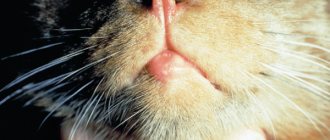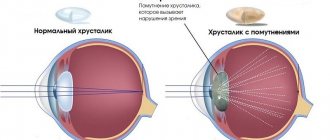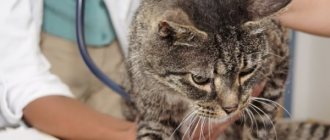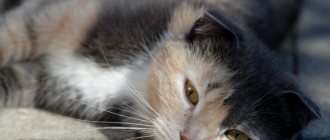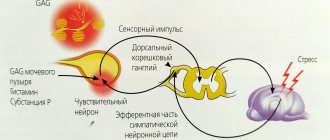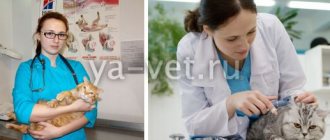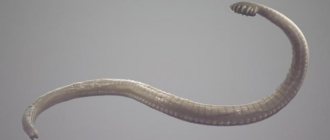Content
1. Causes of occurrence 2. Risk groups 3. Varieties and forms 4. Stages of development 5. Treatment 6. Surgical treatment of the disease is represented by several types: 7. Prevention
Vision is of utmost importance for four-legged pets. Any negative processes associated with decreased visual acuity and complete loss of vision radically change the life of a pet and cause it many problems. Blindness is often caused by cataracts in cats or clouding of the eye lens, which serves as an important optical device. This phenomenon occurs under the influence of many factors. If you contact a professional veterinarian in a timely manner, the chances of saving your vision are quite high.
Types of cataracts in cats
Purchased . It occurs with age for some external (stroke, fall from a height) or internal (infection, medication) reason. Always has a progressive character, i.e. without timely contact with a veterinarian in Moscow continues to develop.
Acquired cataracts are divided into several types, depending on the factors that provoked its development:
- traumatic,
- hormonal (for example, with prolonged use of hormones),
- diabetic,
- genetic,
- senile,
- toxic.
A feature of the acquired form is that impaired metabolism can lead to its development. This means that cataracts can develop even in young cats if they are fed incorrectly, not given vitamins, or do not maintain a balanced diet.
Congenital . In this case, cataracts begin to develop at the embryonic stage. According to the researchers, this may be due to the condition of the cat (for example, if she had severe infectious diseases, this could affect the condition of the fetus).
Treatment of congenital cataracts is very difficult. In some cases, it is not possible to restore the condition of the optical lens of the eye.
Causes
The lens forms the basis of the visual system of the four-legged pet's eye. It has the shape of a biconvex lens, which is necessary for refraction and proper focusing of visible light rays striking the retina. When organic and inorganic deposits accumulate in the tissues of the lens, the processes of cell degeneration are activated. This, in turn, provokes the gradual death of protein components and a change in the thickness of the lens capsule towards its increase. Epithelial cells accumulate on the surface of the lens, as a result of which the organ loses the ability to correctly refract the sun's rays. This means that the cat's cataracts are progressing.
Among all the possible causes of illness in pets, modern veterinarians identify the following:
| Natural aging | The lens can function fully only if it maintains a certain ratio of mineral and protein substances with water. An older pet's metabolism slows down and metabolic rates decrease. This provokes the accumulation of protein and fat deposits, calcium salts, cholesterol, and phosphorus on the surface of the lens. The level of fluid in the lens decreases markedly. |
| Injuries | Injuries leading to mechanical damage to the skull and organs of vision. Quite often, cataracts in a kitten develop as a result of a foreign body entering the visual system or bumping into hard objects. Clouding of the eye lens develops against the background of inflammatory processes progressing in the pet’s body. |
| Ophthalmology | Sometimes cataracts in cats are secondary in nature and are considered as a complication of an ophthalmological disease suffered by the animal. Malaise is caused by various forms of conjunctivitis, glaucoma, entropion of the eyelids, iridocyclitis, and eversion of the eyelids. |
| Hormonal disorders | Pet obesity, diabetes mellitus and urolithiasis are undesirable processes in which loss of vision can easily become a side effect. |
Prevention
You can minimize the likelihood of developing this ophthalmological disease if you adhere to a number of rules. Experts give the following recommendations in this regard:
- Avoid injuring your cat's eyes.
- After 7-8 years of age, your pet should be systematically taken to a veterinary clinic for examination, including an ophthalmological examination. If necessary, the doctor will prescribe special drops for cats.
- It is necessary to promptly begin treatment of concomitant pathologies (urolithiasis, diabetes mellitus, etc.).
- The cat's diet needs to be saturated with vitamins and minerals.
Cataracts in representatives of the cat family are a common pathology. It can develop for various reasons. To avoid complications, you need to contact a veterinary clinic when the first signs of the disease appear.
All information posted on the site is provided in accordance with the User Agreement and is not a direct instruction to action. We strongly recommend that before using any product, you must obtain a face-to-face consultation at an accredited veterinary clinic.
At-risk groups
The greatest attention to the problem of cataracts in cats, symptoms and treatment of the disease is paid to owners of elderly pets aged 8-9 years and older. The active development of senile cataracts occurs against the background of slow metabolism and the accumulation of large volumes of free radicals in the elderly body. Due to the pronounced oxidative effect, free radical molecules can destroy the finest structures of the organs of vision.
If we consider the breed's predisposition to the occurrence of this type of ailment, then the most frequently asked questions are whether cataracts can be cured in cats:
- Persian cats;
- Exotics;
- British;
- Scots.
This is due to the specific structure of the animal’s head, which affects the provision of sufficient nutrition to the tissues of the visual organs. It is surprising that mongrel creatures suffer from such deviations extremely rarely.
Recovery and care for the animal
The success of the operation largely depends on a competent rehabilitation period. The animal is prescribed a course of antibacterial therapy. Ophthalmic eye drops are used to relieve soreness and swelling of the cornea.
In order to prevent postoperative complications, the animal is put on a collar. It will protect against scratching and mechanical damage to the operated area.
During the rehabilitation period, monitoring the condition of the operated eye by a veterinary specialist is important. The inspection is carried out once a month for six months.
We recommend reading about peritonitis in cats. You will learn about the types of peritonitis, routes of infection with viral and infectious peritonitis, symptoms, diagnosis and principles of treatment of peritonitis. And here is more information about the methods of treating cirrhosis in cats.
Stages of development
The appearance of any deviations from the usual behavior of a pet should alert its owner. The cat may begin to bump into objects while moving through familiar territory or lose the ability to navigate in an unfamiliar space. Some pets often miss when trying to grab their favorite toy.
In the dark and at twilight, the animal’s visual acuity will be minimal. In the absence of a proper response to the problem, the lens gradually begins to become cloudy, and the pupil noticeably dilates. The cat's condition becomes depressed. She moves less and less, becomes aggressive or overly fearful.
Main symptoms
The initial stage of cataracts is practically asymptomatic. Decreased vision in a cat cannot be noticed due to the fact that the animals’ hearing and sense of smell are excellently developed.
Pathology manifests itself when the optical areas of the lens are damaged. The cat ceases to navigate in an unfamiliar room, moves unsteadily and bumps into furniture and objects, and becomes awkward in games.
A clear sign of cataracts is the appearance of a spot or film on the eye, indicating clouding of the lens.
Treatment
For cataracts in cats, treatment is prescribed depending on the animal’s current state of health and the nature of the illness. If the problem can be identified at the initial stage, then drug therapy will be highly effective. Once the situation begins to worsen, more drastic measures will be required. In particular, we are talking about the need for surgical intervention.
Regardless of the stage of development of cataracts in cats, treatment should be carried out under the strict supervision of an experienced veterinarian. Sometimes a specialist prescribes immunomodulators and the use of tissue preparations. The pet is prescribed ascorbic acid and vitamin B2.
When conservative methods do not give the desired result, the veterinarian urgently prescribes surgery.
Surgical treatment of the disease is represented by several types:
| Extracapsular resection | In which the specialist removes only the nucleus of the lens, preserving the central and posterior capsules |
| Intracapsular resection | When the lens is subjected to extraction together with the capsule itself. This technique is most popular for early lens removal. |
Separately, we should consider the phacoemulsification technique, when the veterinarian makes a small incision and inserts a special ultrasonic probe through it into the tissue to liquefy and subsequently remove the lens. This technique is considered one of the most progressive, since it allows you to refrain from applying stitches.
In exceptional situations, it is enough for the doctor to make a small puncture in order to use a probe to suck out all the masses of the lens that have undergone pathological changes. This method is not widely used because the risk of recurrence of the disease is too high.
Extraction of the damaged organ is completed with the installation of a new artificial lens. It will be as close in functionality as possible to the cat’s own lens and will successfully cope with the tasks of refracting visible sunlight and maintaining visual acuity sufficient for the pet.
What happens if cataracts are not treated? Are there consequences?
There are other consequences besides blindness, and in most cases they are disastrous. The fact is that when cataracts mature, the changed proteins of the lens gradually extend beyond the boundaries of the lens. Now there is a lot of protein inside the eye, and the immune system of the eye, which has never encountered such a protein before, begins to react to it as if it were foreign.
We invite you to familiarize yourself with: Canned food for cats Zoogourman Special development Zoogourman for cats
Thus, inflammation (uveitis) develops inside the eye, directed against the altered lens. After some time (up to three years), cats almost always develop glaucoma (increased pressure inside the eye) due to uveitis. As a rule, such glaucoma is difficult to treat and often causes eye loss.
